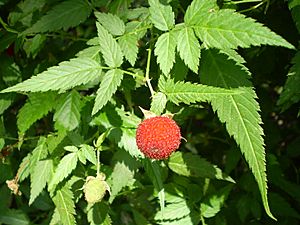Rose-leaf bramble facts for kids
Quick facts for kids Rose-leaf bramble |
|
|---|---|
 |
|
| Scientific classification | |
| Genus: |
Rubus
|
| Species: |
rosifolius
|
| Synonyms | |
|
Synonymy
Rubus rosaefolius Sm.
Rubus chinensis Ser. Rubus comintanus Blanco Rubus commersonii Poir. Rubus commersonii var. simpliciflorus Koidz. Rubus glandulosopunctatus Hayata Rubus hopingensis Y.C.Liu & F.Y.Lu Rubus jamaicensis Blanco Rubus minusculus H.Lév. & Vaniot Rubus tagallus Cham. & Schltdl. Rubus taiwanianus Matsum. Rubus thunbergii var. glabellus Focke Rubus sinensis hort. ex Sims Rubus coronarius (Sims) Sweet Rubus linearifolius Hayata |
|
The Rubus rosifolius, also known as roseleaf bramble or Mauritius raspberry, is a plant that looks like a small, prickly bush. It grows naturally in warm, wet forests in places like the Himalayas, East Asia, and eastern Australia.
You can also find this plant growing a lot in parts of Brazil, especially in the states of Minas Gerais and Rio de Janeiro, and further south to Rio Grande do Sul. It also grows in the wild in Puerto Rico and in the highlands of Indonesia.
Contents
Plant Features
The leaves of the rose-leaf bramble are made up of several smaller leaflets. These leaflets have jagged edges and tiny hairs on both sides. The plant's flowers are white and can grow in clusters or by themselves. The fruits are edible and can be about 2 centimeters long.
In Eastern Australia, the leaves of this plant stay green, and its fruits become ripe in the early autumn.
How People Use This Plant
Even though R. rosifolius is not often grown on farms, it has several uses.
Delicious Fruit
The fruit of the rose-leaf bramble is sweet and tastes good, especially when the plant gets enough water in the soil. People in the Himalayas even sell these fruits in markets.
Herbal Remedies
The leaves of this plant are used to make a special herbal tea. This tea is sometimes used as a traditional medicine to help with:
- Tummy troubles like diarrhoea
- Pains during a girl's period
- Feeling sick in the morning, especially for pregnant women (called morning sickness)
- Helping with pains during childbirth
The leaves contain natural oils that are thought to help with these issues.
What to Watch Out For
In some places, like the Hawaiian Islands, Puerto Rico, and French Polynesia, Rubus rosifolius is not native. This means it was brought there by people and can sometimes cause problems. When a plant grows too much where it doesn't belong, it can become an "environmental weed". This means it can take over and harm the local plants and environment.
Because of this, it's very important to be careful if you think about bringing this plant to new areas where it doesn't already grow naturally.
See also
 In Spanish: Rubus rosifolius para niños
In Spanish: Rubus rosifolius para niños

